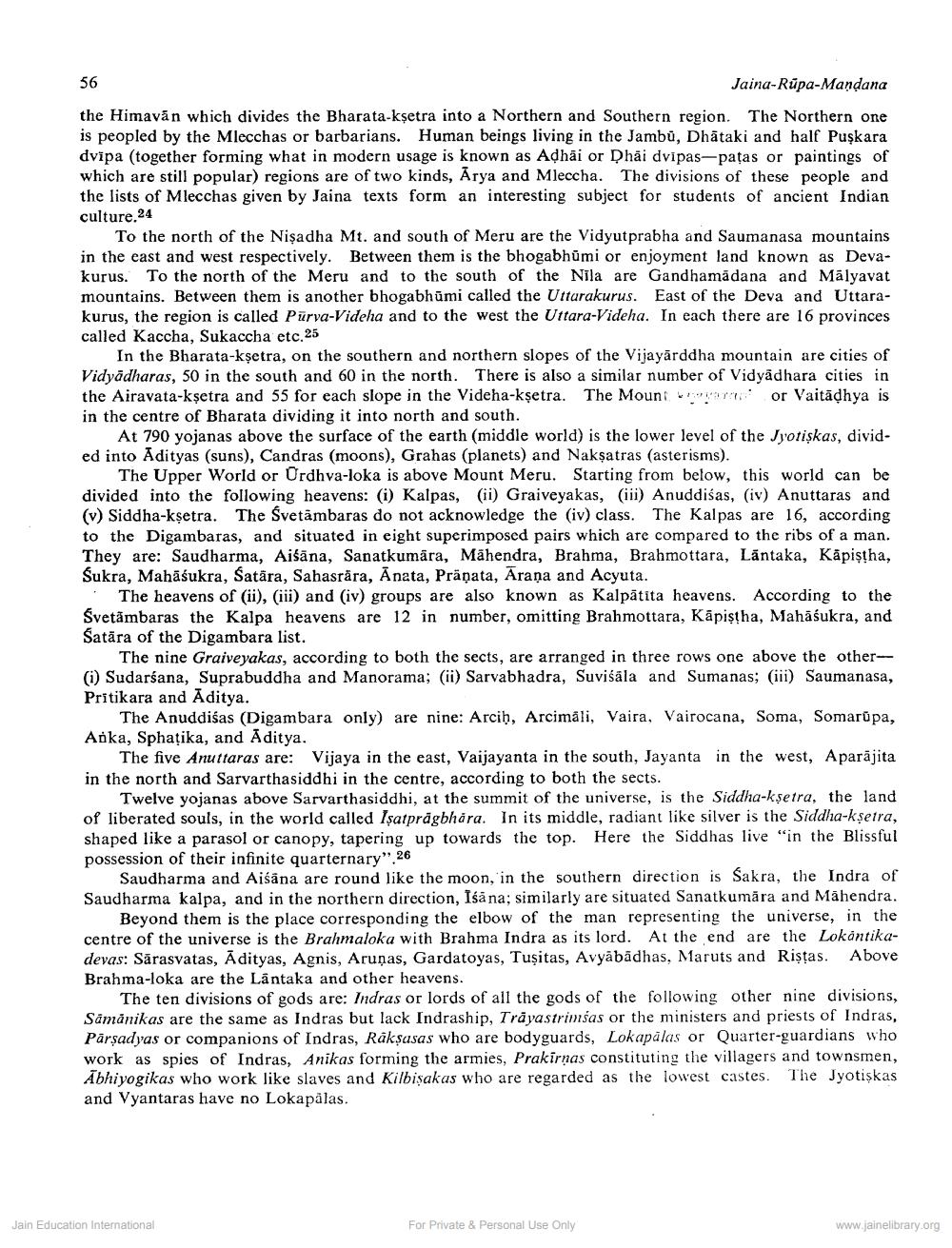________________
56
Jaina-Rupa-Mandana the Himaván which divides the Bharata-ksetra into a Northern and Southern region. The Northern one is peopled by the Mlecchas or barbarians. Human beings living in the Jambu, Dhátaki and half Puskara dvīpa (together forming what in modern usage is known as Adhai or Dhai dvipas-patas or paintings of which are still popular) regions are of two kinds, Arya and Mleccha. The divisions of these people and the lists of Mlecchas given by Jaina texts form an interesting subject for students of ancient Indian culture.24
To the north of the Nişadha Mt. and south of Meru are the Vidyutprabha and Saumanasa mountains in the east and west respectively. Between them is the bhogabhūmi or enjoyment land known as Devakurus. To the north of the Meru and to the south of the Nila are Gandhamadana and Malyavat mountains. Between them is another bhogabhūmi called the Uttarakurus. East of the Deva and Uttarakurus, the region is called Purva-Videha and to the west the Uttara-Videha. In each there are 16 provinces called Kaccha, Sukaccha etc.25
In the Bharata-kşetra, on the southern and northern slopes of the Vijayārddha mountain are cities of Vidyādharas, 50 in the south and 60 in the north. There is also a similar number of Vidyadhara cities in the Airavata-kşetra and 55 for each slope in the Videha-kşetra. The Mount a in or Vaitādhya is in the centre of Bharata dividing it into north and south.
At 790 yojanas above the surface of the earth (middle world) is the lower level of the Jyotiskas, divided into Adityas (suns), Candras (moons), Grahas (planets) and Nakşatras (asterisms).
The Upper World or Ordhva-loka is above Mount Meru. Starting from below, this world can be divided into the following heavens: (i) Kalpas, (ii) Graiveyakas, (iii) Anuddiśas, (iv) Anuttaras and (v) Siddha-ksetra. The Svetambaras do not acknowledge the (iv) class. The Kalpas are 16, according to the Digambaras, and situated in eight superimposed pairs which are compared to the ribs of a man. They are: Saudharma, Aiśāna, Sanatkumāra, Māhendra, Brahma, Brahmottara, Lāntaka, Kāpistha, Sukra, Mahāśukra, Satara, Sahasrāra, Anata, Prāṇata, Arana and Acyuta.
The heavens of (ii), (iii) and (iv) groups are also known as Kalpātīta heavens. According to the Svetămbaras the Kalpa heavens are 12 in number, omitting Brahmottara, Kāpistha, Mahāśukra, and Satära of the Digambara list.
The nine Graiveyakas, according to both the sects, are arranged in three rows one above the other(i) Sudarśana, Suprabuddha and Manorama; (ii) Sarvabhadra, Suvišála and Sumanas; (iii) Saumanasa, Pritikara and Aditya.
The Anuddiśas (Digambara only) are nine: Arciḥ, Arcimāli, Vaira, Vairocana, Soma, Somarupa, Aika, Sphatika, and Aditya.
The five Anuttaras are: Vijaya in the east, Vaijayanta in the south, Jayanta in the west, Aparājita in the north and Sarvarthasiddhi in the centre, according to both the sects.
Twelve yojanas above Sarvarthasiddhi, at the summit of the universe, is the Siddha-kşetra, the land of liberated souls, in the world called Isatprägbhara. In its middle, radiant like silver is the Siddha-kşeira, shaped like a parasol or canopy, tapering up towards the top. Here the Siddhas live "in the Blissful possession of their infinite quarternary" 26
Saudharma and Aiśana are round like the moon, in the southern direction is Sakra, the Indra of Saudharma kalpa, and in the northern direction, Isana; similarly are situated Sanatkumāra and Mahendra.
Beyond them is the place corresponding the elbow of the man representing the universe, in the centre of the universe is the Brahmaloka with Brahma Indra as its lord. At the end are the Lokäntikadevas: Sārasvatas, Adityas, Agnis, Aruņas, Gardatoyas, Tuşitas, Avyābādhas, Maruts and Ristas. Above Brahma-loka are the Lāntaka and other heavens.
The ten divisions of gods are: Indras or lords of all the gods of the following other nine divisions, Sāmānikas are the same as Indras but lack Indraship, Trāyastrimšas or the ministers and priests of Indras, Pārşad yas or companions of Indras, Raksasas who are bodyguards, Lokapālas or Quarter-guardians who work as spies of Indras, Anikas forming the armies, Prakirnas constituting the villagers and townsmen, Abhiyogikas who work like slaves and Kilbişakas who are regarded as the lowest castes. The Jyotiskas and Vyantaras have no Lokapalas.
Jain Education International
For Private & Personal Use Only
www.jainelibrary.org




